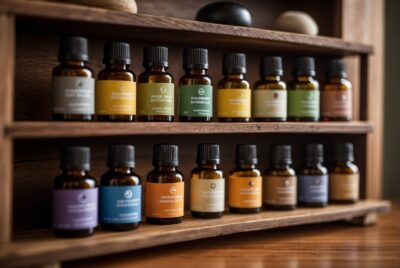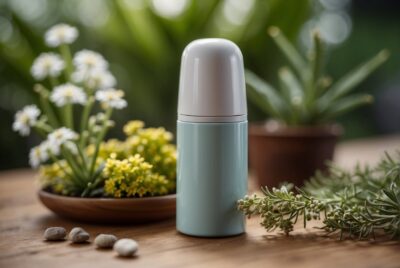Essential Oils for Inflammation: A Natural Approach
*We may earn a commission for purchases made using our links. Please see our disclosure to learn more.
Essential Oils for Inflammation: Effective Natural Remedies
Essential Oils for Inflammation has been an integral part of my recovery routine, so lets jump right in! They have been part of natural remedies for centuries, offering diverse benefits ranging from aromatherapy to topical applications. My studies in the world of alternative medicine have shown that these oils, which are concentrated extracts from plants, often possess properties that can help mitigate inflammation, a natural response of the body to injury or infection. Inflammation is characterized by redness, heat, swelling, pain, and loss of function, and while it is part of the body’s healing process, chronic inflammation can lead to various health issues.

Research on essential oils suggests that certain oils have anti-inflammatory effects that could assist in pain relief and reducing unwelcome inflammation. Oils such as chamomile, lavender, and eucalyptus have been scrutinized for their potential to alleviate symptoms associated with conditions like arthritis, muscle aches, and even skin irritation. These naturally occurring substances target the discomfort directly, providing a sense of relief and aiding in the management of inflammation.
While acknowledging the promising aspects of essential oils, I also recognize the importance of responsible usage and the consideration of scientific evidence when incorporating them into health routines. Knowledge of the correct dilution, application methods, and possible interactions is crucial to maximize their benefits and limit any risks. By exploring essential oils as a complement to traditional medical treatments, I’m able to offer a well-rounded perspective on how these extracts can contribute to managing and reducing inflammation effectively.
Understanding Inflammation and Its Causes

Inflammation is a complex biological response of the body’s immune system to harmful stimuli such as pathogens, damaged cells, or irritants. It’s an essential mechanism for healing, but when it becomes chronic, it can lead to a myriad of health issues. Let’s explore how certain factors like diet and lifestyle can contribute to this process, and what happens at a cellular level during inflammation.
Role of Diet and Lifestyle
Diet and lifestyle play pivotal roles in managing and igniting inflammation. A diet high in processed foods, sugars, and unhealthy fats can trigger an inflammatory response. In contrast, foods rich in omega-3 fatty acids, antioxidants, and phytonutrients can act as anti-inflammatory agents. Similarly, lifestyle factors such as inadequate sleep, high stress levels, and a sedentary lifestyle may exacerbate inflammation. On the other hand, regular physical activity and effective stress management can reduce inflammation, particularly in the joints.
- Pro-Inflammatory Factors:
- High consumption of processed foods and trans fats
- Excessive sugar intake
- Chronic stress and poor sleep quality
- Anti-Inflammatory Interventions:
- Balanced diet with fruits, vegetables, and omega-3
- Regular exercise
- Adequate sleep and stress reduction techniques
The Science Behind Inflammation
Inflammation can be classified into two categories: acute and chronic. Acute inflammation is a short-term, localized response to injury or infection, aimed at eliminating the initial cause of cell injury, clearing out damaged cells and tissues, and establishing repair. The signs of acute inflammation are easily noticeable and include redness, swelling, heat, and pain.
Chronic inflammation, on the other hand, is a prolonged, dysfunctional immune response that can silently damage tissues over time and may play a role in diseases like arthritis, cardiovascular disease, and certain cancers. At the molecular level, the COX-2 enzyme is a key player in the inflammatory process, as it facilitates the production of pro-inflammatory molecules like prostaglandins.
- Acute Inflammation:
- Purpose: Biological defense and repair
- Duration: Short-term; resolves upon healing
- Chronic Inflammation:
- Risks: Prolonged immune response leading to tissue damage
- Associations: Increased risk of various chronic diseases
Through my understanding, I emphasize that preventing and controlling excessive inflammation is essential. A combination of positive dietary choices and lifestyle changes can significantly reduce the risk of chronic inflammation and improve overall well-being.
The Basics of Essential Oils

Essential oils are highly concentrated plant extracts that retain the natural odor and flavor of their source. Understanding their extraction, composition, and methods of use is key to utilizing their benefits effectively.
Extraction and Composition
Extraction: The process I’m discussing involves separating the aromatic compounds from plants, which can be achieved through several methods. The most common techniques include steam distillation, where steam is used to vaporize the oil, and cold pressing, mainly used for citrus oils, which involves mechanically pressing the plant material.
Composition: Essential oils are composed of volatile compounds that are responsible for the plant’s scent and flavor. Their complexity and potency mean that tailoring their use to specific needs is vital for the best results. Purity of the essential oils also plays an important role as it affects their therapeutic value.
Methods of Using Essential Oils
1. Aromatherapy: In this approach, essential oils are inhaled indirectly or directly. Devices such as a diffuser can disperse the oil into the air, offering respiratory benefits and altering mood or stress levels.
Example of using a diffuser:
- Fill the diffuser with water.
- Add a few drops of essential oil.
2. Topical Application: Essential oils are often applied to the skin for absorption. Due to their potency, they should be diluted with a carrier oil to minimize skin sensitivity. Dilution typically ranges from a 1% to 5% concentration, which corresponds to 1-5 drops of essential oil per teaspoon of carrier oil.
Essential oil dilution:
| Purpose | Essential Oil Drops | Carrier Oil |
| General use | 1-2 | 1 teaspoon |
| Stronger dose | 3-5 | 1 teaspoon |
When using essential oils topically, it’s vital to perform a patch test to ensure no allergic reactions occur.
By familiarizing myself with these basics, I can use essential oils in a manner that maximizes their natural benefits while maintaining safety and efficacy.
Popular Essential Oils for Inflammation

My experience leads me to recognize several essential oils well-regarded for their anti-inflammatory properties. These oils can be topically applied or diffused but should be used with proper knowledge and dilution guidelines.
Eucalyptus and Peppermint Oils
- Eucalyptus Oil: Scientifically valued for its high concentration of eucalyptol, I find eucalyptus to possess significant anti-inflammatory and analgesic qualities. It’s especially beneficial for respiratory inflammation when inhaled.
- Peppermint Oil: I consider peppermint oil highly effective due to menthol, which provides a cooling sensation offering relief from inflammatory pain. It’s a common choice for users suffering from muscular aches or joint pain.
Ginger and Turmeric Oils
- Ginger Oil: Containing gingerol, I recommend ginger oil for its warm, soothing effect on inflammation. Its analgesic properties make it a suitable choice for addressing muscle stiffness and joint discomfort.
- Turmeric Oil: With curcumin as a primary compound, turmeric oil stands out in my list for its strong anti-inflammatory action. I often suggest it for its potential to help alleviate chronic inflammation-related conditions.
Lavender and Chamomile Oils
- Lavender Oil: Known for its versatile properties, lavender oil is my go-to for various inflammatory issues including skin irritations and stress-induced conditions. It’s gentle and can be used by most individuals.
- Chamomile Oil: Chamomile, particularly German chamomile, has azulene which I’ve found helpful in reducing skin inflammation and promoting relaxation. Its effectiveness in removing redness and irritation makes it a staple in my kit.
Creating Effective Blends and Applications
I recognize the importance of adequately blending and applying essential oils to manage inflammation safely and effectively. Creating suitable dilutions and understanding the best techniques for application are integral to the process.

Dilution Ratios and Safety
Before applying any essential oil topically, it’s crucial to dilute it with a carrier oil. Carrier oils, like jojoba or coconut oil, help to disperse the active compounds and minimize the risk of skin irritation. A general guideline I follow for dilution is to add about 6 drops of essential oil to 30 ml (2 tablespoons) of carrier oil, which amounts to a 1% dilution ratio. This ratio is typically safe for most adults. Always perform a patch test on a small area of skin and wait 24 hours to ensure there are no adverse reactions before applying a new blend more broadly.
For specific needs, such as acute inflammation, a higher concentration, such as a 3% dilution (20 drops essential oil in 30 ml carrier oil), might be appropriate, but I advise this only for short-term use and under the guidance of a healthcare professional.
Below is a table outlining simple dilution ratios:
| Dilution Percentage | Essential Oil Drops | Carrier Oil Volume |
| 1% | 6 | 30 ml (2 Tbsp) |
| 2% | 12 | 30 ml (2 Tbsp) |
| 3% | 20 | 30 ml (2 Tbsp) |
Topical Application Techniques
For applying these blends topically to manage pain and inflammation, I’ve found the following methods to be effective:
- Massage: After diluting the essential oil blend, I like to gently massage it into the affected area. This method not only helps the oil penetrate the skin but also provides the additional benefits of massage, which can further alleviate discomfort.
- Compress: Sometimes, applying a warm or cold compress infused with an anti-inflammatory essential oil blend can offer pain relief. To do this, I add a few drops of the diluted blend to a compress and apply it to the inflamed area, being mindful to adjust the temperature to my comfort.
Using these techniques, I’ve seen considerable benefits when addressing localized inflammation, such as that associated with arthritis or muscle strain. Essential oils renowned for their anti-inflammatory properties include turmeric, frankincense, and chamomile, among others. However, remember that essential oils are potent, and their efficacy and safety depend on proper use and application.
Precautions and Consultations

When considering essential oils for inflammation, I prioritize safety and efficacy. I know it’s essential to be well-informed about potential risks and to seek professional guidance.
Understanding Potential Risks
When I use essential oils, I am always mindful of possible side effects. These natural compounds are potent and can sometimes cause skin irritation or exacerbate a skin condition. I ensure a patch test is conducted before full application to detect any adverse reactions. I’m also cautious about using these oils if I’m pregnant, as they can have unforeseen effects on both my health and the baby’s. Additionally, I consider any allergies I might have, as some essential oils can trigger allergic responses.
Furthermore, I’m cognizant of how essential oils may interact with medications, particularly anti-inflammatory medications. Essential oils can impact the effectiveness of other treatments or might affect the body’s inflammatory enzymes. Thus, I always consult a doctor to avoid any harmful interactions.
When to Seek Medical Advice
I ensure to seek medical advice in several instances regarding the use of essential oils for inflammation:
- If I’m already taking other medications for inflammation or any other condition
- In case I’m experiencing persistent skin inflammation despite using anti-inflammatory oils
- If I’m pregnant, planning to become pregnant, or breastfeeding
- When I suspect an allergic reaction or experience an unexpected side effect
- If my inflammatory condition is severe or does not improve, indicating that I might need more conventional treatment options
Consulting a healthcare provider helps me use essential oils safely alongside other treatments and determine the best course of action for my health.
Frequently Asked Questions
In addressing inflammation, I’ve found essential oils to be a valuable option. Here are some specific inquiries answered about their application and effects.
1. How can essential oils be applied to alleviate inflammation?
I recommend topical application of diluted essential oils as the best method to alleviate inflammation. Mixing with a carrier oil such as coconut or jojoba oil and then applying to the affected area can reduce swelling and soothe pain.
2. Which essential oils offer the best relief for joint and muscle pain?
For joint and muscle pain, I’ve noted that essential oils such as ginger, frankincense, and turmeric are highly effective. They are traditionally known for their anti-inflammatory properties and can offer relief when massaged into the painful areas.
3. Can essential oils be effectively used to reduce skin inflammation?
Yes, essential oils like lavender, tea tree, and chamomile can be effective for skin inflammation. They should be applied in a diluted form to prevent irritation. These oils are recognized for their soothing and anti-inflammatory effects on the skin.
4. What are the recommended ways to diffuse essential oils for reducing inflammation?
Diffusing essential oils such as eucalyptus or peppermint can help reduce inflammation. Using an ultrasonic diffuser or adding a few drops to hot water for steam inhalation are methods I recommend for diffusing these oils.
5. Are there any particular essential oils recommended by experts for their strong anti-inflammatory properties?
Experts often point to eucalyptus, frankincense, and ginger essential oils for their strong anti-inflammatory properties. These oils can be particularly potent in reducing inflammation when used properly.




